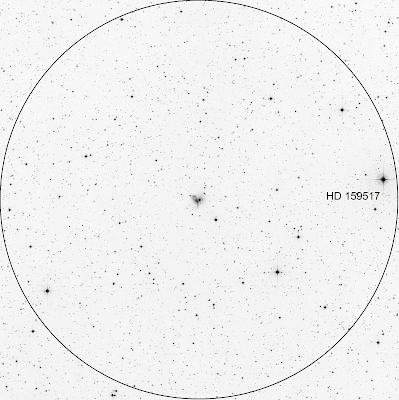A Distorted Galaxy Pair, or Maybe a Triplet System, can be Found in the Modest Constellation Octans, Home of the South Pole Star.
 |
The faint constellation Octans seen from Pampa El Leoncito (San Juan, Argentina).
Photo by the author.
|
 |
Figure 1. The NGC 6438 system and its surrounding field. North is up.
Photo by STSCI DSS. |
Morphology of the system
NGC 6438, described in Dreyer`s catalog as "pretty bright, very gradually brighter in the middle" was also described by Shapley & Paraskevopoulos (1939) as a strange pair, probably a physical double, one spheroidal and the other belonging to the Magellanic type. A second description is given well afterward by Sérsic (1966) in which he notes the weak extension toward the north-preceding of the SO (NGC 6438) galaxy and the remarkable appearance of the irregular object (NGC 6438A) showing a nucleus and a disk of slightly smaller dimensions than the main body of the SO galaxy” (read more in the paper NGC 6438: A Triple System? C. J. Donzelli1, and M. Espíndola 1996). These researchers state that their analysis suggests that NGC 6438 is an interacting triplet, one S0 galaxy and two disk galaxies undergoing a merger, rather than a double system (E+S). In its now old paper "Southern Peculiar Galaxies II - NGC 6438" Sèrsic (1966) states that there are no radio sources coinciding with these galaxies. The Revised Data for NGC 6438 says that one of the galaxies is S0 type while the other one is a type ring B. This system appears also in the "Catalogue of Southern Peculiar Galaxies and Associations" (H. Arp, B. Madore, and W. Roberton) as AM 1806-852, in the category 2b: E+S interaction. In this sub-category an E-like galaxy is interacting with another galaxy which is classifiable as a disk or spiral galaxy. The sub-category contains some very disrupted pairs shown in the middle of the section, and spirals with long, open arms at the end.
 |
Figure 2. The interacting system NGC 6438 (upper panel) and the fainter
components of the system NGC 2573A & B (lower panel).
Photo by STSCI DSS. |
At 78x the view improves a little, the group of stars and the galaxy itself can be identified, but it is not an easy view. The shape of the very faint and smooth nebulosity looks, for moments, irregular (maybe a suggestion of the fainter companion NGC 6438A, a type Ring B galaxy with a visual magnitude of 11.6 and a surface brightness 12.5 (mag per square arcmin) according to the Wolfgang Steinicke's Revised NGC and IC Catalog web page).
106x is a good magnification. Observing carefully and always with averted vision as help NGC 6438 appears, for moments, round and easier to see (or less hard to detect) than its elongated companion, NGC 6438A, that seems to be visible because a very faint, elongated East-West hazy structure reaches the star GSC-9527-1716, a faint 12.8 magnitude star (see upper panel on Figure 2). The whole systems look rather smooth in brightness, situated close to the chain of stars labeled with blue circles in Figure 2. All those stars could be glimpsed as very faint points of lights that night. The stars of the tight pair at one of the ends have magnitudes of 12.9 and 14. The star at the opposite end has a visual magnitude of 14.7 and it could be barely glimpsed through the 8-inch telescope, indicative of a dark, clean, and steady night for deep-sky observations.
196x was, maybe, the magnification that made it possible to see the galaxy pair more clearly, being always a challenging picture for an 8-inch. Taking advantage of the excellent seeing and very good transparency that night NGC 6438 was seen, at this power, round and with a slightly brighter core. An elongated hazy structure can be glimpsed roughly East-West as was aforementioned. Remember, an appropriate dark adaptation and the use of averted vision is a must to see this obscure target. A little worse view was obtained at even higher magnification (266x), with NGC 6438 barely glimpsed in the field of view, and with NGC 6438A not clearly identified.
A close encounter seems to take place in the Universe, not far from the southernmost point where you can aim a telescope from Earth, the south celestial pole.
_________________________________________________________________________________
* NGC 6438A is not an NGC object but it is sometimes called in that way. This is the galaxy PGC 61793.

